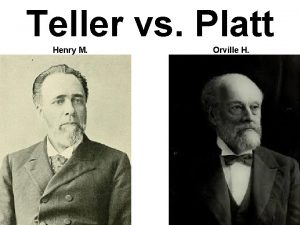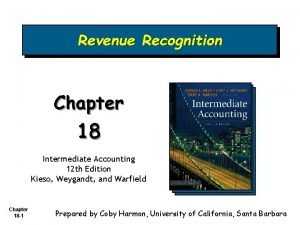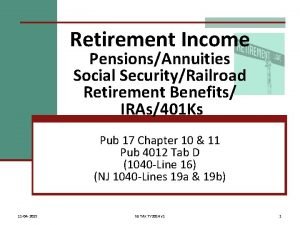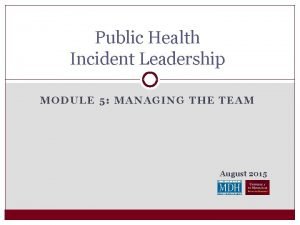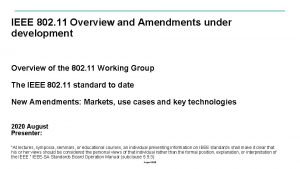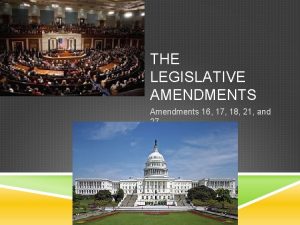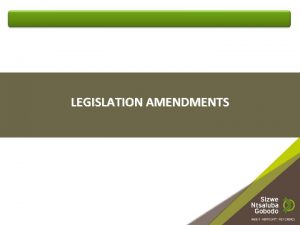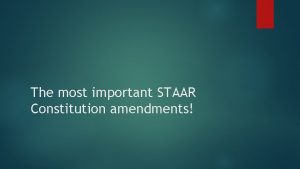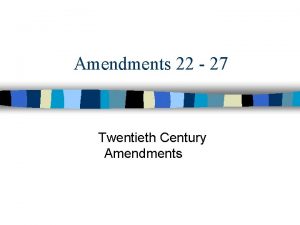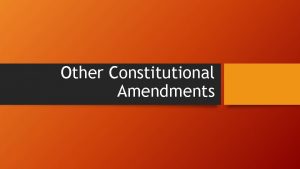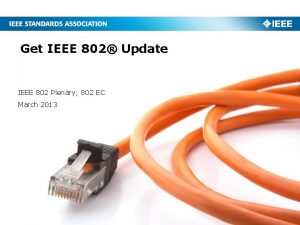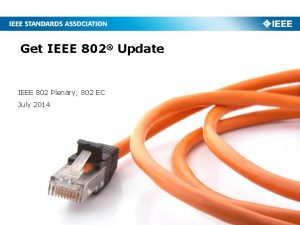IEEE 802 11 Overview and Completed Amendments Overview




















- Slides: 20

IEEE 802. 11 Overview and Completed Amendments Overview of the 802. 11 Working Group The IEEE 802. 11 standard to date Completed Amendments: Markets, use cases and key technologies 2019 April Presenter: “At lectures, symposia, seminars, or educational courses, an individual presenting information on IEEE standards shall make it clear that his or her views should be considered the personal views of that individual rather than the formal position, explanation, or interpretation of the IEEE. ” IEEE-SA Standards Board Operation Manual (subclause 5. 9. 3) April 2019 1

IEEE Standards Association Maintaining the Standard Individual membership 6, 879 individual members in 90 countries Corporate Memberships Gaining Final Approval 187 member corporations in 23 countries Standards Developers Balloting the Standard ~20, 000 participants; all interested parties are welcome April 2019 Initiating the Project Mobilizing the Working Group Drafting the Standard 2

The IEEE 802. 11 Working Group is one of the most active WGs in 802 Focus on link and physical layers of the network stack Leverage IETF protocols for upper layers OSI Reference Model IEEE 802 Local and Metropolitan Area Networks Standards Committee (LMSC) Application Presentation Session Transport Network IEEE 802. 1 Higher Layer LAN Protocols 802. 3 CSMA/CD Ethernet 802. 11 Wireless WLAN 802. 15 Wireless Specialty Networks Data Link 802. 16 Wireless Broadband Access 802. 18 Radio Regulatory TAG 802. 19 Co-existence WG 802. 21 Media Independent Handoff 802. 22 Wireless Regional Area Networks 802. 24 Vertical App. TAG IEEE 802. 11 WG Voting Members: 300+ Physical Medium April 2019 3

Type of Groups in 802. 11 Type of Group Description WG Working Group SC Standing Committee TG Task Group SG Study Group TIG Topic Interest Group AHG Ad Hoc Group April 2019

IEEE 802. 11 Subgroups Type Group WG & Infrastructure WG WG 11 The IEEE 802. 11 Working Group SC AANI SC SC SC 802 SC ARC COEX PAR JTC 1 Advanced Access Networking Interface (AANI) Architecture Coexistence PAR review ISO/IEC JTC 1/SC 6 Type Group New Work SC SG TIG WNG Wireless Next Generation Various Study Groups Various Topic Interest Groups Type Group TG TG TG AH AI AJ AK AQ April 2019 Amendments/Revision Sub 1 GHz unlicensed Fast Link Setup 802. 11 ad (60 GHz) updates for China General Link Pre-association Service Discovery

Development of the IEEE 802. 11 Standard is ongoing since 1997 MAC 11 aa Video Transport 11 ae Qo. S Mgt Frames 11 k RRM 11 s Mesh 11 u WIEN 11 v Network Management 11 z TDLS 11 w Management Frame Security 11 r Fast Roam PHY & MAC 802. 11 -2016 802. 11 -2012 11 h DFS & TPC 11 i Security 11 d Intl roaming 11 f Inter AP 802. 11 -2007 802. 11 -2003 11 j JP bands 11 a 54 Mbps 5 GHz 11 g 54 Mbps 2. 4 GHz 11 b 11 Mbps 2. 4 GHz 11 ac -VHT >1 Gbps @ 5 GHz 11 ad - VHT >1 Gbps @ 60 GHz 11 p WAVE IEEE Std 802. 11 -1997 1 -2 Mbps 11 n High Throughput (>100 Mbps) 11 af TV Whitespace 11 e Qo. S 11 y Contention Based Protocol April 2019

IEEE 802. 11 Standards Pipeline MAC 802. 11 bc (BCS) 802. 11 aq PAD 802. 11 REVmd 802. 11 ak GLK 802. 11 az NGP Study Group(s) WNG Topic Interest Group(s) 802. 11 bd NGV 802. 11 bb LC 802. 11 -2016 802. 11 ax HEW 802. 11 ah < 1 Ghz 802. 11 ay NG 60 802. 11 aj CMMW 802. 11 be EHT MAC & PHY Discussion Topics 802. 11 ai FILS 802. 11 ba WUR TIG/Study groups TG without Approved draft WG Letter Ballot April 2019 Sponsor Ballot Published Amendment Published Standard

Completed 802. 11 technologies to meet expanding market needs and leverage new technologies • 802. 11 ah – Operating in license-exempt bands below 1 GHz (excl. TV bands) • 802. 11 ai – Fast initial link set-up • 802. 11 aj – Enable 802. 11 ad operation in the Chinese 59 -64 GHz frequency band. • 802. 11 ak – General Link • 802. 11 aq – Pre-association Service Discovery • ARC – Architecture (Ongoing discussion topics) April 2019

802. 11 ah defines OFDM PHY and MAC operating in license-exempt bands below 1 GHz (excl. TV bands) – Define OFDM PHY and MAC operating in license-exempt bands below 1 GHz (excl. TV bands) – – Extended range Power efficiency Large number of devices Potential Applications – – – Internet of everything (Io. T) Smart Grid Monitor Healthcare Smart Appliances Wearable consumer electronics April 2019 9

802. 11 ah technical features PHY 11 ah bandwidths Mandatory & Globally Interoperable modes optimized for sensor networking 1 150 Kbps – 4 Mbps 2 Optional higher data rate modes for extended range - – OFDM (FFT size 32 and 64) – New reliable MCS-10 working with larger delay spread and Doppler for outdoor – Diverse data rates: 150 Kbps-347 Mbps – Range >1 km MAC 4 – Scalability up to 8191 devices per AP ü ü 8 16 Restrict Access Window operation Hierarchical TIM structure – Efficient frames and transmissions 5. 8 -78 Mbps* Minimum 11 n/ac bandwidth 20 MHz *For 1 spatial stream and normal guard interval only. 11 ah supports up to 4 spatial streams and short guard interval providing data rates up to ~347 Mbps ü ü ü Short frame format Short control/mgmt. frames Asymmetric & bi-directional transmissions – Reducing power consumption ü ü ü Non-TIM operation Target Wake Time mechanism Extended sleeping and listen interval – Relay Operation

802. 11 ai defines fast initial link set-up methods – This amendment defines mechanisms that provide IEEE 802. 11 networks with fast initial link set-up methods which do not degrade the security currently offered by Robust Security Network Association (RSNA) already defined in IEEE 802. 11. – The project’s primary need came from an environment where mobile users are constantly entering and leaving the coverage area of an existing extended service set (ESS). – – – scale with a high number of users simultaneously entering an ESS minimize the time spent within the initial link set-up phase securely provide initial authentication. April 2019 1

802. 11 ai technical features STA 11 i AP AS STA DHCP 11 ai AP AS DHCP Beacon/Probe Resp Auth Req/Resp Authentication Association & IP addr EAP (PEAP/MSCHAPv 2) 802. 11 ai reduces connection setup overhead by: Improvement on scanning EAPOL Key DHCP More control on scanning procedures or association attempt Neighbor BSS or channel information in Beacon, Probe Response and FILS Discovery frame FILS Authentication protocol FILS shared key authentication with or without PFS Public key authentication method with PFS Higher Layer Setup during Association/Reassociation Higher Layer Protocol encapsulation FILS IP configuration 10/31/2020 12

802. 11 aj defines modifications to 802. 11 ad to enable operation in the Chinese 59 -64 GHz frequency band – This amendment defines modifications to the IEEE P 802. 11 ad Physical (PHY) layer and the Medium Access Control (MAC) layer to enable operation in the Chinese 59 -64 GHz frequency band. – The amendment maintains backward compatibility with 802. 11 ad when it operates in the 5964 GHz frequency band. – The amendment also defines modifications to the PHY and MAC layers to enable the operation in the Chinese 45 GHz frequency band. The amendment maintains the 802. 11 user experience. April 2019 1

802. 11 aj technical features 11 aj considers the following: • Link Budget Analysis for 40 -50 GHz Indoor Usage • Multi-Carrier Training Field for OFDM Transmission in the 45 GHz • Packet Encoding Solution for 45 GHz • A Proposed frame structure is as follows 10/31/2020 14

802. 11 ak enables an 802. 11 connection to be used as a through link in a general network – This amendment enables an 802. 11 connection to be used as a through link in a general network, not just as a connection to an end station at the edge of a network. – Fully general mixed 802. 11 and wired plug and play in the home. – Data Center top-of-rack to top-of-rack connections for overflow traffic. – Industrial and Enterprise network use. April 2019 1

802. 11 aq enables the delivery of pre-association Service Discovery information – A typical use case is printer discovery in a hotel – Pre-association protocol designed to discover services on a WLAN April 2019 1

802. 11 aq technical features – Container MAC protocol to carry upper layer service discovery protocols (e. g. UPn. P, Bonjour) – Provisioning and configuration of services in the access point – – Universal identification of services – – – Service Transaction Proxy is a logical element connected to the access point Using a hash name Provide service attributes (e. g. 3 D printer capability or point of sale service) Currently considering request/response or broadcast concept

The ARChitecture SC (ARC) meets on an ongoing basis – It does not develop a standard or amendment – Discussion of 802. 11 architecture issues for other ongoing amendments – Topics for discussion include: – Architectural clauses and models in the standard, as questions, or needs for update or clarification arise. – Relationships with outside groups on 802. 11 architectural topics, or topics that don’t fit elsewhere, such as IETF, 802 O&A, and 802. 1. April 2019 1

ARC technical considerations – Models for STA architecture and related concepts, and overall system architecture, included in the Standard in clauses 4 and 5, generally. – Evolution of the models, either to consider amendments to the Standard, or as clarification is needed – Define how 802. 11 technologies fit into 802, 802. 1 and IETF use cases.

Thank You Questions April 2019 20
 Bridges from 802.x to 802.y
Bridges from 802.x to 802.y Bridges from 802.x to 802.y
Bridges from 802.x to 802.y Estandares 802
Estandares 802 802 ieee
802 ieee Ieee 802 family
Ieee 802 family Ieee802.22
Ieee802.22 Ieee 802 standard
Ieee 802 standard Ieee 802
Ieee 802 Ieee 802 3 compliance
Ieee 802 3 compliance Arquitetura ieee 802
Arquitetura ieee 802 802 15
802 15 Teller vs platt amendment
Teller vs platt amendment Formal vs informal changes to the constitution
Formal vs informal changes to the constitution The fifth, sixth, seventh, and eighth amendments protect *
The fifth, sixth, seventh, and eighth amendments protect * As requested i am enclosing a completed job application
As requested i am enclosing a completed job application Completed design
Completed design Civil engineering completed risks
Civil engineering completed risks College brag sheet
College brag sheet Completed contract method
Completed contract method Form 5329
Form 5329 Completed ics 215 form
Completed ics 215 form











